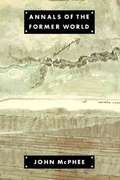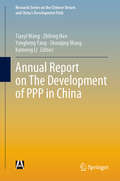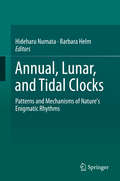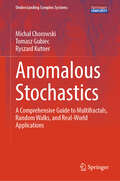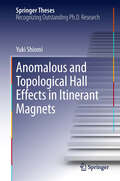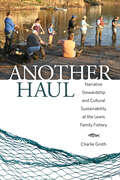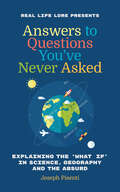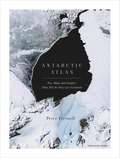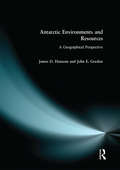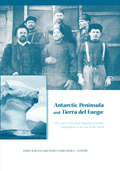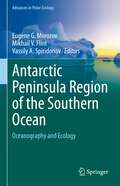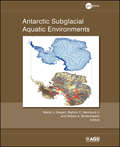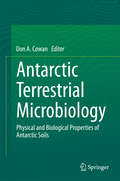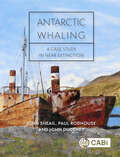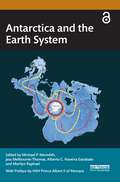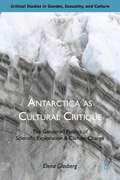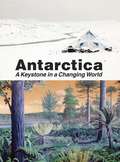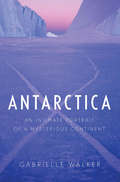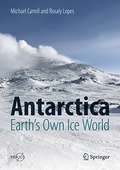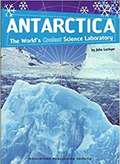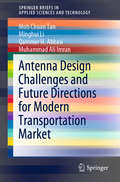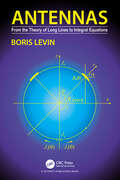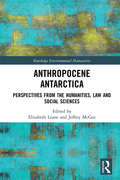- Table View
- List View
Annals of the Former World
by John McpheeJohn McPhee describes a cross-section of North America and comes to an understanding not only of the science but of the style of the geologists he traveled with. Completed in four stages under the collected title: Annals of the Former World. <P><P> Winner of the Pulitzer Prize.
Annual Report on The Development of PPP in China (Research Series on the Chinese Dream and China’s Development Path)
by Tianyi Wang Zhifeng Han Yongheng Yang Shouqing Wang Kaimeng LiThis book gathers invited top experts on Public-Private partnership (PPP) in China, from both theoretical and practical fields, to present the most comprehensive analyses of PPP’s practice in China up to 2017. This timely book offers researchers and practitioners a thorough understanding of the PPP’s development in China, including its definition, its modes, its features as well as its many kinds of applications into different industries including medical care, environmental protection, education, public works, park development, etc. It addresses diverse themes in PPP analyses such as quantitative analyses and qualitative analyses; data statistics and case study, theoretical framework modeling and field study verification. The book is an overview of the Chinese PPP development through 2017.
Annual, Lunar, and Tidal Clocks: Patterns and Mechanisms of Nature's Enigmatic Rhythms
by Hideharu Numata Barbara HelmThere is more to biological rhythms than circadian clocks. This book aims at promoting the exciting potential of a deeper understanding of circannual, circatidal, and circalunar clocks. It highlights new developments, summarizes existing knowledge, and integrates different perspectives with the tools and ideas of diverse fields of current biology. For predominantly pragmatic reasons, research in recent decades was mostly concerned with circadian clocks. Clocks on other timescales, however, have been largely neglected and therefore still appear "enigmatic". Thanks to the rapid development of methods in molecular biology as well as in ecology, we are now able to re-approach these clocks. Laboratories around the world are showing fresh interest and substantial progress is being made in many independent projects. The book's two sections address the moon-derived circatidal, circasemilunar, and lunar cycles on the one hand (10 chapters), and the sun-derived circannual cycles on the other (6 chapters). This work brings together authors with an expansive array of expertise and study systems, ranging from tidal cycles of marine invertebrates to annual cycles of birds and mammals, and from behavioral to genetic and epigenetic backgrounds. While great challenges remain to be mastered, the book aims at conveying the excitement of unraveling, broadly, the rhythms of life.
Anomalous Stochastics: A Comprehensive Guide to Multifractals, Random Walks, and Real-World Applications (Understanding Complex Systems)
by Michał Chorowski Tomasz Gubiec Ryszard KutnerThis textbook provides a comprehensive exploration of anomalous stochastic processes and extreme events, commonly referred to as "black swans," with a particular focus on (multi-)fractal approaches and continuous-time random walks. The authors present a systematic examination of the subject, tracing its inception and providing a multi-directional perspective. By drawing on real-world experiences in finance, physics, and technology, the book underscores the practical relevance of anomalous stochastic processes for practitioners dealing with real-world data from complex systems. The content is based on a series of interdisciplinary physics lectures that have been delivered to undergraduate and graduate students at the University of Warsaw for nearly two decades. Updated to reflect recent developments, this book is a valuable resource for graduate students, ambitious undergraduate students, and researchers interested in random processes and the practical implications of anomalous processes. Familiarity with fundamental principles of probability theory, algebra, and basic concepts of differential and integral calculus is assumed, while a foundational understanding of mathematical statistics, stochastic processes, and statistical thermodynamics is recommended. Additionally, each chapter includes practical exercises designed to help readers master the concepts, develop practical skills, and serve as teaching material.
Anomalous and Topological Hall Effects in Itinerant Magnets (Springer Theses)
by Yuki ShiomiThis book presents an investigation of the anomalous and topological Hall effects in some itinerant ferromagnets and helimagnets by measurements of Hall effects driven by electrical or heat current. New clarifications are provided for spin-dependent Hall effects induced by the Berry phase, skew scattering, and scalar spin chirality. The author reveals the scattering-free nature of the Berry-phase-induced anomalous Hall current by conducting the first comparative study of electrical and thermal Hall effects. The impurity-element dependence of the anomalous Hall effect caused by skew scattering is systematically investigated in the low-resistivity region for Fe. Two new examples showing a topological Hall effect are found in helimagnets, in which nonzero scalar spin chirality arises from the modulation of spin structure through Dzyaloshinsky-Moriya (DM) interaction. Such a DM-interaction-mediated topological Hall effect is a new type of topological Hall effect. Also the temperature dependence of topological Hall terms in the thermal Hall effect and Nernst-Ettingshausen effect is found to be totally different from that in the electrical Hall effect. These results will be useful for applications of spin current to devices with low power consumption.
Another Haul: Narrative Stewardship and Cultural Sustainability at the Lewis Family Fishery (Folklore Studies in a Multicultural World Series)
by Charlie GrothLewis Island in Lambertville, New Jersey, is the site of the Lewis Fishery, the last haul seine American shad fishery on the nontidal Delaware River. The Lewis family has fished in the same spot since 1888 and operated the fishery through five generations. The extended Lewis family, its fishery’s crew, and the Lambertville community connect with people throughout the region, including environmentalists concerned about the river. It was a Lewis who raised the alarm and helped resurrect a polluted river and its biosphere. While this once exclusively masculine activity is central to the tiny island, today men, women, and children fish, living out a sense of place, belonging, and sustainability.In Another Haul: Narrative Stewardship and Cultural Sustainability at the Lewis Family Fishery, author Charlie Groth highlights the traditional, vernacular, and everyday cultural expressions of the family and crew to understand how community, culture, and the environment intersect. Groth argues there is a system of narrative here that combines verbal activities and everyday activities.On the basis of over two decades of participation and observation, interviews, surveys, and a wide variety of published sources, Groth identifies a phenomenon she calls “narrative stewardship.” This narrative system, emphasizing place, community, and commitment, in turn, encourages environmental and cultural stewardship, tradition, and community. Intricate and embedded, the system appears invisible, but careful study unpacks and untangles how people, often unconsciously, foster sustainability. Though an ethnography of an occupation, the volume encourages readers to consider what arises as special about all cultures and what needs to be seen and preserved.
Anoxia: Evidence for Eukaryote Survival and Paleontological Strategies (Cellular Origin, Life in Extreme Habitats and Astrobiology #21)
by Joseph Seckbach Joan M. Bernhard Alexander AltenbachANOXIA defines the lack of free molecular oxygen in an environment. In the presence of organic matter, anaerobic prokaryotes produce compounds such as free radicals, hydrogen sulfide, or methane that are typically toxic to aerobes. The concomitance of suppressed respiration and presence of toxic substances suggests these habitats are inhospitable to Eukaryota. Ecologists sometimes term such environments 'Death Zones'. This book presents, however, a collection of remarkable adaptations to anoxia, observed in Eukaryotes such as protists, animals, plants and fungi. Case studies provide evidence for controlled beneficial use of anoxia by, for example, modification of free radicals, use of alternative electron donors for anaerobic metabolic pathways, and employment of anaerobic symbionts. The complex, interwoven existence of oxic and anoxic conditions in space and time is also highlighted as is the idea that eukaryotic inhabitation of anoxic habitats was established early in Earth history.
Answers to Questions You've Never Asked: Explaining the 'What If' in Science, Geography and the Absurd
by Joseph PisentiThe #1 bestselling trivia collection with bizarre facts to entertain you for hours, from the creator of YouTube&’s RealLifeLore. Where can I move to so that I&’m never tempted by McDonald&’s again? How far into the Pacific does Trump&’s wall stretch? If Plato came back to life, what would he think of modern democracy? Why do all empires fail? Who decides what countries are allowed to participate in the Olympics? What makes Finland so great? When you take the most absurd parts of history, science, economics, and geography, you end up with a pretty confusing picture of humanity. Why do we have borders, what&’s the furthest you can get from the ocean, how do you qualify as a country, and why did Vikings wear those silly helmets? These are just a few of the strange questions that bounce around the head of YouTube sensation Joseph Pisenti, aka RealLifeLore. In his debut book, Pisenti explores the nonsensical humor of the universe with in-depth analysis of empires, economies, and ecosystems as he helps answer the ridiculous. Why, you ask? Because someone has to. Using line drawings, graphs, and charts, Pisenti not only details the absurd—he also provides explanations on why things are . . . and why they aren&’t.
Antarctic Atlas: New Maps and Graphics That Tell the Story of A Continent
by Peter FretwellA FINANCIAL TIMES BOOK OF THE YEAR 2020SHORTLISTED FOR THE ESTWA AWARD FOR ILLUSTRATED TRAVEL BOOK OF THE YEAR 2022One of the least-known places on the planet, the only continent on earth with no indigenous population, Antarctica is a world apart. From a leading cartographer with the British Antarctic Survey, this new collection of maps and data reveals Antarctica as we have never seen it before.This is not just a book of traditional maps. It measures everything from the thickness of ice beneath our feet to the direction of ice flows. It maps volcanic lakes, mountain ranges the size of the Alps and gorges longer than the Grand Canyon, all hidden beneath the ice. It shows us how air bubbles trapped in ice tell us what the earth's atmosphere was like 750,000 years ago, proving the effects of greenhouse gases. Colonies of emperor penguins abound around the coastline, and the journeys of individual seals around the continent and down to the sea bed in search of food have been intricately tracked and mapped. Twenty-nine nations have research stations in Antarctica and their unique architecture is laid out here, along with the challenges of surviving in Antarctica'sunforgiving environment.Antarctica is also the frontier of our fight against climate change. If its ice melts, it will swamp almost every coastal city in the world. Antarctic Atlas illustrates the harsh beauty and magic of this mysterious continent, and shows how, far from being abstract, it has direct relevance to us all.
Antarctic Environments and Resources: A Geographical Perspective
by John Gordon J.D. HansomAntarctica is no longer a 'pole apart'. From a scientific perspective, the Antarctic ice sheet, ocean and climate systems are intimately linked with the global climate and are now seen to be of international significance for understanding climate change. From an economic perspective, the Antarctic is perceived to have great potential as a source of marine resources although the extent of speculated mineral and hydrocarbon resources is unknown. From a conservation perspective, the continent of Antarctica represents the ideal image of unspoiled wilderness.Antarctic Environments and Resources is an accessible and timely new geography of the Antarctic which examines the differing and sometimes conflicting interests in the great southern continent, the Southern Ocean and the subantarctic islands against a background of the physical and natural systems of the region and their interactions. It charts the development of human involvement in the area, focusing on the exploitation of resources from early sealing to modern fisheries, tourism and science, and it assesses the consequent impacts on the natural environment. The text also reviews the emerging framework for future environmental management developed under the Antarctic Treaty System.This is an ideal text for undergraduates studying glacial geomorphology, environmental management, polar regions and the Antarctic.
Antarctic Glacial History and World Palaeoenvironments
by E.M. van Zinderen BakkerThis book, based on the proceedings of third symposium held on 17th August 1977 during the Xth INQUA Congress at Birmingham, UK, focuses on the influence the Antarctic glaciation had on world palaeoenvironments.
Antarctic Peninsula & Tierra del Fuego: Proceedings of "Otto Nordensjold's Antarctic Expedition of 1901-1903 and Swedish Scientists in Patagonia: A Symposium", Buenos Aires, Argentina, March 2-7, 2003
by Jorge Rabassa María Laura BorlaThis symposium, held in Argentina in March 2003, commemorates Otto Nordenskjold's 1901 expedition, and pays tribute to the Swedish and Argentinian explorers who took on the challenge of early fieldwork in Patagonia and Antarctica. This theme is extended to include recent fieldwork in the natural sciences in the Archipelago of Tierra del Fuego, the
Antarctic Peninsula Region of the Southern Ocean: Oceanography and Ecology (Advances in Polar Ecology #6)
by Eugene G. Morozov Mikhail V. Flint Vassily A. SpiridonovThe book is based on results from the Russian expedition in the region of the Antarctic Peninsula and Powell Basin in the northern part of the Weddell Sea, as well as on the review of earlier research in the region. The main goal of the research was to collect the newest data and study the physical properties and ecology of this key region of the Southern Ocean. Data analysis is supplemented with numerical modeling of the atmosphere-ocean interaction and circulation in the adjacent region, including research on rogue waves. The focus of the study was the Antarctic Circumpolar Current, currents and water properties in the Bransfield Strait and Antarctic Sound, properties of seawater, currents, ecosystem and biological communities in the Powell Basin of the northwestern Weddell Sea, and their variations. An attempt is made to reveal the role of various components of the Antarctic environment in the formation of biological productivity and maintenance of the Antarctic krill population. This is especially important as in the last decades the Antarctic environment has experienced significant changes related to the global climatic trends.
Antarctic Subglacial Aquatic Environments
by Martin J. Siegert Robert A. Bindschadler Mahlon C. Kennicutt IIPublished by the American Geophysical Union as part of the Geophysical Monograph Series, Volume 192.Antarctic Subglacial Aquatic Environments is the first volume on this important and fascinating subject. With its underlying theme of bridging existing knowledge to future research, it is a benchmark in the history of subglacial lake exploration and study, containing up-to-date discussions about the history and background of subglacial aquatic environments and future exploration. The main topics addressed are identification, location, physiography, and hydrology of 387 subglacial lakes; protocols for environmental stewardship and protection of subglacial lake environments; details of three programs aiming to explore Vostok Subglacial Lake, Ellsworth Subglacial Lake, and Whillans Subglacial Lake over the next 3-5 years; assessment of technological requirements for exploration programs based on best practices for environmental stewardship and scientific success; and knowledge of subglacial lakes as habitats for microbial life and as recorders of past climate and ice sheet change. Its uniqueness, breadth, and inclusiveness will appeal to microbiologists and those interested in life in extreme environments, paleoclimatologists and those interested in sedimentary records of past changes, glaciologists striving to understand how water beneath glaciers affects their flow, and those engaged in developing technology to undertake direct measurement and sampling of extreme environments on Earth and in the solar system.
Antarctic Terrestrial Microbiology: Physical and Biological Properties of Antarctic Soils
by Don A. CowanThis book brings together many of the world's leading experts in the fields of Antarctic terrestrial soil ecology, providing a comprehensive and completely up-to-date analysis of the status of Antarctic soil microbiology. Antarctic terrestrial soils represent one of the most extreme environments on Earth. Once thought to be largely sterile, it is now known that these diverse and often specialized extreme habitats harbor a very wide range of different microorganisms. Antarctic soil communities are relatively simple, but not unsophisticated. Recent phylogenetic and microscopic studies have demonstrated that these communities have well established trophic structuring and play a significant role in nutrient cycling in these cold and often dry desert ecosystems. They are surprisingly responsive to change and potentially sensitive to climatic perturbation. Antarctic terrestrial soils also harbor specialized 'refuge'habitats, where microbial communities develop under (and within) translucent rocks. These cryptic habitats offer unique models for understanding the physical and biological 'drivers' of community development, function and evolution.
Antarctic Whaling: A Case Study in Near Extinction
by John Sheail Paul Rodhouse John DudeneyAntarctic Whaling explores how British whalers came to claim so large a share of the whales taken from the Southern Ocean in the first half of the twentieth century, and, more particularly, where, when, how and why the British Government came to play so large a part in whaling history through its endeavour to regulate the whaling grounds.
Antarctica and the Earth System
by Michael P. Meredith Jess Melbourne-Thomas Naveira Garabato, Alberto C. Marilyn RaphaelThis book presents a state-of-the-art overview of the role that Antarctica and the Southern Ocean play as integral parts of the Earth System.While often characterised as the last great wilderness on Earth, Antarctica is intimately connected to the rest of the planet, exerting key influences on all places and all people. It is also vulnerable to global changes, especially those driven by humans. This book examines how Antarctica and the Southern Ocean are connected to the rest of the planet, and what these connections mean for the future of Planet Earth and all its inhabitants. It transcends traditional disciplinary boundaries to explore this role across physical, ecological, political, and social systems. Drawing on the latest research findings and thinking, the volume identifies the current leading-order challenges across each of these spheres, highlighting areas where enhanced focus is needed. With the role of Antarctica in the Earth System being one of the most relevant themes of our times, this book will help audiences to understand Antarctica and the Southern Ocean in a global perspective.Antarctica and the Earth System will be of great interest to a wide range of interdisciplinary students and scholars of Earth sciences, Antarctic studies, polar science, and environmental management.The Open Access version of this book, available at http://www.taylorfrancis.com, has been made available under the Creative Commons Attribution (CC-BY) 4.0 license.
Antarctica as Cultural Critique
by Elena GlasbergArguing that Antarctica is the most mediated place on earth and thus an ideal location for testing the limits of bio-political management of population and place, this book remaps national and postcolonial methods and offers a new look on a 'forgotten' continent now the focus of ecological concern.
Antarctica: A Keystone in a Changing World
by National Research Council of the National AcademiesAntarctica is the center from which all surrounding continental bodies separated millions of years ago. Antarctica: A Keystone in a Changing World, reinforces the importance of continual changes in the country's history and the impact of these changes on global systems. The book also places emphasis on deciphering the climate records in ice cores, geologic cores, rock outcrops and those inferred from climate models. New technologies for the coming decades of geoscience data collection are also highlighted. Antarctica: A Keystone in a Changing World is a collection of papers that were presented by keynote speakers at the 10th International Symposium on Antarctic Earth Sciences. It is of interest to policy makers, researchers and scientific institutions.
Antarctica: An Intimate Portrait of a Mysterious Continent
by Gabrielle WalkerThe acclaimed science writer presents a wide-ranging exploration of Antarctica&’s history, nature, and global significance in this &“rollicking good read&” (Kirkus). From the early expeditions of Ernest Shackleton to David Attenborough&’s documentary series Frozen Planet, the continent of Antarctica has captured the world&’s imagination. After the Antarctic Treaty of 1961, decades of scientific research revealed the true extent of its many mysteries. Now former Nature magazine staff writer Gabrielle Walker tells the full story of Antarctica—from its fascinating history to its uncertain future and the international teams of researchers who brave its forbidding climate. Drawing on her broad travels across the continent, Walker weaves all the significant threads of life on the vast ice sheet into a multifaceted narrative, illuminating what it really feels like to be there and why it draws so many different kinds of people. She chronicles cutting-edge science experiments, visits to the South Pole, and unsettling portents about our future in an age of global warming. &“We are all anxious Antarctic watchers now, and Walker's book is the essential primer.&”—The Guardian, UK
Antarctica: Earth's Own Ice World (Springer Praxis Books)
by Michael Carroll Rosaly LopesIn 2016, scientist Rosaly Lopes and artist Michael Carroll teamed up as fellows of the National Science Foundation to travel to Mount Erebus, the world’s southernmost active volcano in Antarctica. The logistics of getting there and complex operations of Antarctica's McMurdo Station echo the kinds of strategies that future explorers will undertake as they set up settlements on Mars and beyond. This exciting popular-level book explores the arduous environment of Antarctica and how it is similar to other icy worlds in the Solar System.The bulk of this story delves into Antarctica’s infrastructure, exploration, and remote camps, culminating on the summit of Erebus. There, the authors explored the caves and ice towers on the volcano’s flanks, taking photographs and generating original art depicting scenes in Antarctica and terrestrial analogs on other planets and moons. Readers will see an intimate side of Mount Erebus and Antarctica while surveying the region’s history, exploration, geology, and volcanology, which includes research funded by the National Science Foundation’s United States Antarctic Programs. Richly illustrated with photographs and stunning paintings showcasing the beauty of the harsh continent, the book captures the spirit and splendor of the authors’ journey to Erebus.
Antarctica: The World's Coolest Science Laboratory
by John LockyerAntarctica: The World's Coolest Science Laboratory by John Lockyer.
Antenna Design Challenges and Future Directions for Modern Transportation Market (SpringerBriefs in Applied Sciences and Technology)
by Muhammad Ali Imran Qammer H. Abbasi Moh Chuan Tan Minghui LiThis book is focused on wireless infrastructure deployment in modern transportation markets, where the wireless infrastructure co-exists with the existing structure. It details the challenges this deployment may face and explores the mitigation measures to overcome the challenges. The book proposes a smart antenna structure to overcome airspace congestion, which improves the overall wireless performance and deployment cost. With the combination of practical know-how and theoretical estimation, this book provides insight on how the modern smart antenna techniques that support most cutting-edge wireless technology can be adopted into the existing infrastructure whilst minimising the distraction to the existing system. This book is suitable for industrial and academic researchers, practising engineers within the field of smart antennae, and wireless infrastructure designers and developers.
Antennas: From the Theory of Long Lines to Integral Equations
by Boris LevinThis book describes both known and new results. In the sections devoted to the use of integral equations for the current in a linear metal radiator, the focus is on Leontovich's equation. An advantage of this equation is the simplicity of the solution and the absence of the argument φ in it because the integration over φ already performed. The refined solution makes it possible to determine the total sum of the series for the current, which is close to the known solution including only the first terms. The results of the synthesis of different types of antennas with capacitive loads are presented, which makes it possible to implement Hallen's hypothesis about the usefulness of applying such loads to create an in-phase current distribution in antennas and to obtain required characteristics.New results include the widespread use of the complex potential method in relation to the calculation of capacitive structures in homogeneous and inhomogeneous media, antenna patterns and flows of electrical fields between antenna elements and in the surrounding space. In particular, the analysis of field flows makes it possible to substantiate a rigorous method for analyzing microstrip antennas. The characteristics of antennas in various conditions of their installation are considered and compared. The results of the use of multi-floors structures that provide in the wide frequency range the radiation in direction perpendicular to the antenna axis, and structures that make it possible to reduce the mutual influence of antennas located at different heights on a common mast are described.
Anthropocene Antarctica: Perspectives from the Humanities, Law and Social Sciences (Routledge Environmental Humanities)
by Elizabeth Leane Jeffrey McGeeAnthropocene Antarctica offers new ways of thinking about the ‘Continent for Science and Peace’ in a time of planetary environmental change. In the Anthropocene, Antarctica has become central to the Earth’s future. Ice cores taken from its interior reveal the deep environmental history of the planet and warming ocean currents are ominously destabilising the glaciers around its edges, presaging sea-level rise in decades and centuries to come. At the same time, proliferating research stations and tourist numbers challenge stereotypes of the continent as the ‘last wilderness.’ The Anthropocene brings Antarctica nearer in thought, entangled with our everyday actions. If the Anthropocene signals the end of the idea of Nature as separate from humans, then the Antarctic, long considered the material embodiment of this idea, faces a radical reframing. Understanding the southern polar region in the twenty-first century requires contributions across the disciplinary spectrum. This collection paves the way for researchers in the Environmental Humanities, Law and Social Sciences to engage critically with the Antarctic, fostering a community of scholars who can act with natural scientists to address the globally significant environmental issues that face this vitally important part of the planet.
